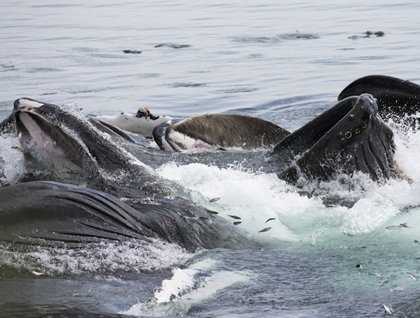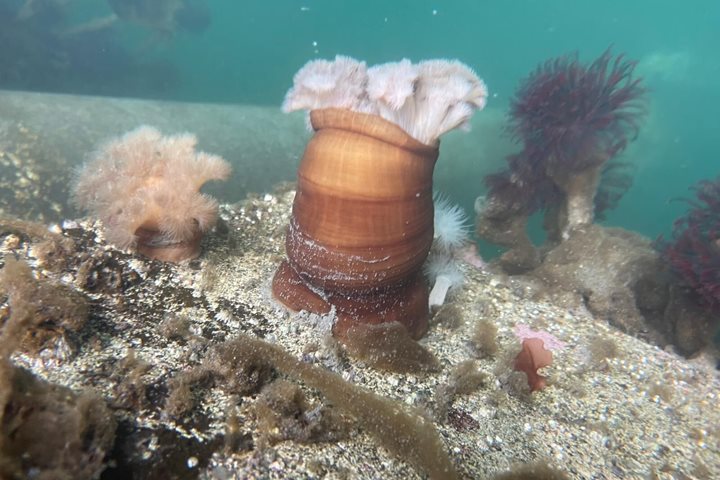The first day of our expedition started in the best possible way, with calm waters and nice weather. The National Geographic Sea Bird made her way through Tenakee Inlet and, on the eastern portion of Chichagof Island, we were all on deck searching for wildlife. We soon discovered not one, not two, but four brown bears grazing on a meadow at the end of Crab Bay. The magnificent carnivores actually rely more on plant matter during this time of the year, before most berries are ripe and the salmon runs start, so they eat a lot of grasses and sedges. We watched them for a long time before continuing our search; before long we observed a large number of harbor seals hauled out on the beach, many of them with their newborn pups and accompanied by numerous bald eagles. The raptors wait patiently around in hopes to make a meal out of the placentas during the pupping season.
After exiting the entrance of Crab Bay, we encountered a group of ten humpback whales. Although there is a big number or humpbacks in Southeast Alaska during this time of the year, and it is common to see many whales in any given area, a group of individuals traveling close to each other made us suspicious; we followed them and a bit later our suspicions were confirmed as all ten whales came up to the surface at the same time in a tight group in the middle of a ring of bubbles. It was a group of bubblenetters! We couldn’t believe our luck, as there is only a small group of individuals in all Southeast Alaska that engage into this intriguing and fascinating feeding behavior. As the whales dive together and find prey—herring, in this case—one of them swims in a circle below the future meal and blow bubbles, creating a rising curtain that scares the fish and forces them get into a tight ball in the center. All whales swim up at unison and break the surface with their mouths wide open as the poor herring jump for dear life in one of nature’s most amazing displays. We watched the same scene over and over, a few times extremely close to the ship!
During the early afternoon we arrived at Pavlof Harbor, where we had a great time; many of us went hiking along the stream and enjoyed our first exploration of the Tongass National Forest. We admired the beauty and serenity of the temperate rain forest environment and learned about the many plant and animal species that call it home, including Sitka spruce, beaver, devil’s club, brown bear, skunk cabbage, and many more. Several of us also went kayaking and explored the shoreline and got a different perspective. I also went scuba diving and brought back underwater video of several beautiful species like giant plumose anemones, hooded nudibranchs, sea cucumbers, and many more.
We eventually made our way back to our comfortable floating home, happy for having had such a great day. And it is only the beginning!







